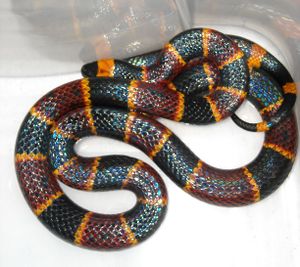Snake bites
Background
- In the United States, snake bites can be organized into Crotaline (Pit Vipers) and Elapidae (Coral Snakes)
- Crotalidae family also includes rattlesnakes, Sistrurus and Agkistrodon species (water moccasins and copperheads).[1]
- Risk Factors: "The 'T's" Testosterone, Tequila, Tshirt, Tattoos, Toothless, Teasing, Trailer park, Truck
Clinical Features
- Local injury - punctures marks from fangs not always visible, erythema, and edema
- Nausea/vomiting
Differential Diagnosis
Envenomations, bites and stings
- Hymenoptera stings (bees, wasps, ants)
- Mammalian bites
- Closed fist infection (Fight bite)
- Dog bite
- Marine toxins and envenomations
- Toxins (ciguatera, neurotoxic shellfish poisoning, paralytic shellfish poisoning, scombroid, tetrodotoxin
- Stingers (stingray injury)
- Venomous fish (catfish, zebrafish, scorpion fish, stonefish, cone shells, lionfish, sea urchins)
- Nematocysts (coral reef, fire coral, box jellyfish, sea wasp, portuguese man-of-war, sea anemones)
- Phylum porifera (sponges)
- Bites (alligator/crocodile, octopus, shark)
- Scorpion envenomation
- Reptile envenomation
- Spider bites
Diagnosis
- Clinical Diagnosis
Treatment
- Treatment mainly depends upon the presence of an envenomation
- Always provide supportive care and treat local effects of any wounds
- 8Irrigation of the wound
- Debridement and removal of devitalized tissue may be necessary for severe bites
- Snake specific treatments depend upon Coral snake or Pit viper envenomations
Disposition
See Also
References
- ↑ Goldfranks Toxicology - Envenomations




